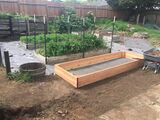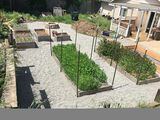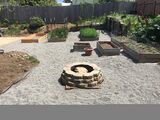King Pig's property project


Abstract[edit | edit source]
Due to this period in time when everything is said to be related to covid19, the engineering project that the 3SEEDS team were planning on completing during the Spring semester of 2020 was canceled. This allowed me (User:KingPig42) to put all my time, money, and energy into my own property which I have been slowly transforming for a little over 3 years now. My goal for this project was at first to build 1 rainwater catchment system but I was doing more projects already, why not combine them all into "My Own CCAT Project." So my plan is to bring everything CCAT has into my own property. This includes green building, gardening,agriculture, composting, rainwater catchment systems, landscaping, and other means of appropriate technology. I will continue to add to this page as I move ahead with future projects to finish the full transformation.
Background[edit | edit source]
This project is off Cal Poly Humboldt grounds and at my own home on my own property. This project will be led by myself with the help of family members, possibly some help from my friends. The majority though will be all me. The project will take place all around the property as I transform the entire landscape 360 degrees around the house. Reasons for the project is for my own educational benefits including the hands on experience. Being on my own property, any upgrades to it will increase the value to my property and over time create a self sustaining home within Eureka city limits. Short term goals include growing my own food and medicines as well as adding rainwater for all my watering needs. Also making the grounds easier to maintain and for aesthetics purposes. I started some aspects of this project throughout the last 3 years but since my engineering project has been brought home for the semester, I have been putting a lot of time into it. The official start of this semesters project at home started approximately on March 16, 2020. Long term goals is to eventually make this home completely self sustainable and to create a community space where kids and families can come over and learn to grow and build sustainably. If crypto booms for me, I'd like to possibly donate my property for a South Humboldt State CCAT house. We'll see what the future holds.
Problem Statement[edit | edit source]
The objective of this project is to maximize the space on my property using as many appropriate technology ideas and designs as possible while making the space aesthetically pleasing. This includes adding rainwater catchment systems, retaining walls and fire pit construction using green building methods and recycled materials, improving the garden to grow food and medicine, and rebuilding my composting system to make it easier to access and maintain.
Connected Project Team[edit | edit source]
3SEEDS:
Project Evaluation Criteria[edit | edit source]
The following Criteria will be used to assess the success of this project. These criteria were chosen based on the suggestions of the project coordinator as well as the diligent students who are working on the catchment system. The scale (1-10) represents the importance level of meeting the constraint of each listed criteria.
| Criteria | Constraints | Weight (1-10) |
|---|---|---|
| Community | make it an enjoyable, educational, and productive space for family, friends, and community | 10 |
| Maintainability | Must be easy to clean, keep organized, and do repairs | 8 |
| Aesthetics | Must be pleasing to the eye while using mostly recycled and reused materials | 10 |
| Space | maximize the space provided | 10 |
| Safety & Placement of projects | Be smart | 9 |
| Simplicity | easy to use & easy to access | 8 |
| Productivity | Produce as much natural resources, foods, and medicines as possible | 10 |
| Cost | Keep it cheap as possible but saving headaches as well | 8 |
| Functionality | successfully creates more resources for communal needs | 10 |
Literature Review[edit | edit source]
This is a review of the available literature pertinent to some of the projects on my property.
Project Types[edit | edit source]
There are 4 projects that are the main focus during this timetable on the semester. The projects include the following: A rainwater catchment system for my frontside rain gutter. Adding 6 new garden beds to improve my food and medicine production. Also to teach and encourage my kids to grow their own food and eat healthy. Completing a retaining wall that I had started nearly 2 years ago using old growth redwood is completed now. Digging out a little more than half my backyards grass, I have added gravel for ease of maintenance. The last one is the fire pit and circle seating area around it to provide a social center piece to enjoy the company of family and friends on those summer nights.
Rainwater Catchment Barrel[edit | edit source]
This rainwater catchment system is using a 220L barrel storage tank with a spicket at the bottom to allow for flushing rather than ading a first flush to the system. This is a simple and easy system to use, operate, and maintain. It is connected to a 7ft rainwater gutter above my frontside patio. A custom conveyance piece was added to bring the water to the barrel. Examples of systems can be found in Lonny Grafman's book "To Catch the Rain."[1]
Additional Garden Beds[edit | edit source]
A total of 6 new garden beds will have been made by end of the semester. 2 are 11ftx4ft and will matching the already existing 2 beds. Those will be used for medicinal purposes. 3 new beds have been made at 6ftx3ft and 1 bed 3ftx3ft. Those beds will be for the fruits & veggies. Already planted are 40+ strawberries, 6 broccolli, snap peas, and rodelika carrots. Later, 2 varieties of watermelon and pickling cucumbers will be added. The garden beds were made using used fence boards that were not being used. Recycled materials. Extra rainwater stored can help individuals and communities grow more food.[2] A book on composting and gardening to help get started is "The Complete Compost and Gardening Guide."[3]
Retaining Wall[edit | edit source]
The old growth redwood retaining wall has been completed after starting on it almost 2 years ago. This was made using recycled old growth redwood to provide a rustic looking wall that provides separation between the high and low grounds. I wanted the wall to look as though it was from the wild west and I think I nailed it without even using any nails:) A good book for sustainable landscape construction is "Sustainable Landscaping for Dummies."[4]
Aesthetically Pleasing Landscape[edit | edit source]
A large portion of this project that is always overlooked in any landscaping project is the amount of grass and dirt removal that is needed. So I dug up over half my backyard to get rid of the over grown grass that grows high every winter rain. Once it was all dug out, I added 4 cubic yards of pea gravel to eliminate future grass and weed growth. This will help with the amount of maintenance that is required each year to keep up with the overgrowth. It also allows for more time to spent growing food and medicine.
Fire Pit[edit | edit source]
I built a fire pit using materials that I had laying around the yard such as bricks and pavers. Simple and easy to build and use. I cut out a seating circle around it as well to allow seating. This will help with social gatherings on nice spring and summer nights cooking hotdogs and making smores with the kids.
Construction[edit | edit source]
-
thumb
-
thumb Connection piece connecting gutter to barrel
-
thumbStarting of the digging
-
new boxes and fire pit
-
Medicine beds & retaining wall
-
Dig around garden beds
-
Fire Pit Area
-
Garden fabric down
-
rocks delivered
-
Gravel done
-
View from the back of the fire pit
Budget Proposal[edit | edit source]
| Quantity | Material | Source | Cost ($) | Total ($) |
|---|---|---|---|---|
| 1 | 220L Barrel w/spicket | Local Container Seller | 75.00 | 75.00 |
| 1 | Flexible Connector | Piersons | 10.00 | 10.00 |
| 1 | 3ftx3ft net | Joannes | 1.50 | 1.50 |
| 1 | Hot Glue Gun & Glue | Joannes | 5.00 | 5.00 |
| 4 | Cubic Yards Pea Gravel | Powell | 250.00 | 250.00 |
| 7 | Fruits & Veggies | Piersons | 100.00 | 100.00 |
| 1 | Load of old growth redwood posts | Local | 100.00 | 100.00 |
| 3 | Gopher screens | Piersons | 180.00 | 180.00 |
| Total Cost | $721.00 | |||
- Cost of Current Project(s)
Proposed timeline[edit | edit source]
| Dates | Objective |
|---|---|
| 3/16/2020 | Start individual project |
| 3/18/2020 | Purchased water barrel |
| 3/28/2020 | Installed 220L barrel and hooked up to frontside rain gutter. |
| 3/30/2020 | 1st flush completed from 1 whole barrel |
| 4/4/2020 | Digging began to make space for fire pit and garden beds |
| 4/16/2020 | Fire Pit construction finished |
| 4/18/2020 | 5 of 6 garden beds complete, soil added, and started planting |
| 4/20/2020 | Finished old growth redwood retaining wall |
| 4/24/2020 | All grass, drainage ditches, and ground leveling completed.Garden fabric down ready for gravel |
| 4/29/2020 | 4 cubic yards of pea gravel added throughout garden space. Main projects completed |
| 4/30/2020 | Final Appropedia Page Creation, final project write up, and video completed |
| 5/4/2020 | Future Projects & Continuation, Evaluations |
Operation[edit | edit source]
This is only for the rainwater catchment barrel
Maintenance[edit | edit source]
I have left the top of the barrel open so the water pours in through the lid and through the mosquito netting and into the barrel. Because of this, debris that comes down may be left on top the lid or netting. The location of this system is located at the front gate entrance so when I walk by, I look to check for debris. Remove the lid ring, take off the lid and shake the debris off. Screw lid back on and place gutter spout back on the netting. Every 6 months when barrel is emptied, remove barrel from site and hose out or clean out to remove any sediment build up at the bottom.
Conclusion[edit | edit source]
The rainwater catchment for the front is complete because of what I need it for.However I will be adding a larger one in the back possibly this summer. The plants are already growing in some of the garden beds and we've already enjoyed hanging around at night around the fire pit. Still have more to continue with which you can see in the "future project" section.
- Testing, Discussion,lessons learned, and next steps are focused only on the rainwater catchment barrel
Testing Results for the Rainwater Catchment[edit | edit source]
First rain I had to make downspout adjustments. Since then it has worked as it is suppose to
Discussion[edit | edit source]
The first 3 barrels worth of water have been filled now and working properly. The way I left the lid and spout allows for the overflow to simply pour over the top. Easily drains with the use of the spicket at the bottom.
Lessons Learned[edit | edit source]
No matter how easy you think it is, prototyping as much as you can will more than likely improve your set up. Snails like to climb up the barrel. Pros and cons of having the downspout connected and sealed vs sitting on top the lid. Both work but depends on what the water is being used for. Landscaping your own property and doing all the labor yourself is a lot harder than initially realized but rewardings. Also takes much longer than originally planned.
Next Steps[edit | edit source]
Continue improving my property while using appropriate technology designs and ideas. Teach my kids along the way
Additional Information & Video(s)[edit | edit source]
For more information on water catchment systems, click the link below:
To find out more about Cal Poly Humboldt's Campus Center for Appropriate Technology (CCAT), click the link below:
Rainwater Catchment System[edit | edit source]
From Lonny Grafman's "To Catch the Rain," rainwater harvesting is to catch water falling from the sky to use it with a more direct purpose before becoming dirtier from the ground. Rainwater catchment systems are created to catch that water and can be made several different ways because it is a technology that can be customized to fit where needed. Components to a rainwater catchment system usually entails a catchment surface, conveyance which include the gutters and downspout, screens, first flush, storage, purification, and end use.[5]
Books on Water Catchment[edit | edit source]
- Rainwater Harvesting for Drylands and Beyond, Volume 1, 2nd Edition: Guiding Principles to Welcome Rain into Your Life and Landscape by Brad Lancaster ISBN 978-0977246434
- Lancaster ISBN 978-0977246410Rainwater Harvesting for Drylands and Beyond (Vol. 2): Water-Harvesting Earthworks by Brad
- Water Storage: Tanks, Cisterns, Aquifers, and Ponds For Domestic Supply, Fire and Emergency Use by Art Ludwig ISBN 0-9643433-6-3
- To Catch the Rain
YouTube Channel: The Haze Crypto & Cannabis[edit | edit source]
To stay up to date with my current and future projects, subscribe to our channel. You will be entered to win future cryptocurrency giveaways just for being subscribed:)
Future Projects & Continuation[edit | edit source]
- 2 Additional retaining walls
- More garden spaces on other half of yard
- Constructing my new composting system where my chicken coop use to be
- Adding 2 275gal IBC tote rainwater catchment system with first flush in the backyard for the garden
- 1 large hugelkultur space
- Addition of solar panels
References[edit | edit source]
- Grafman, Lonny. To Catch the Rain:1.1 Rainwater Harvesting (pg3-7)
- Grafman, Lonny. To Catch the Rain: Inspiring Stories of Communities Coming Together to Catch Their Own Rain, and How You Can Do It Too. Arcata, CA: Cal Poly Humboldt Press, 2017.
- Barbara, and Deborah L. Martin. The Complete Compost and Gardening Guide. Storey Publishing, 2008.
- Dell, Owen E. Sustainable Landscaping for Dummies. Wiley Publishing, Inc, 2009











